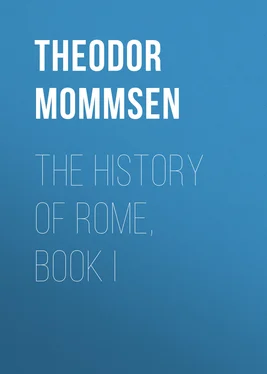Theodor Mommsen - The History of Rome, Book I
Здесь есть возможность читать онлайн «Theodor Mommsen - The History of Rome, Book I» — ознакомительный отрывок электронной книги совершенно бесплатно, а после прочтения отрывка купить полную версию. В некоторых случаях можно слушать аудио, скачать через торрент в формате fb2 и присутствует краткое содержание. Жанр: foreign_prose, История, foreign_edu, foreign_antique, на английском языке. Описание произведения, (предисловие) а так же отзывы посетителей доступны на портале библиотеки ЛибКат.
- Название:The History of Rome, Book I
- Автор:
- Жанр:
- Год:неизвестен
- ISBN:нет данных
- Рейтинг книги:5 / 5. Голосов: 1
-
Избранное:Добавить в избранное
- Отзывы:
-
Ваша оценка:
- 100
- 1
- 2
- 3
- 4
- 5
The History of Rome, Book I: краткое содержание, описание и аннотация
Предлагаем к чтению аннотацию, описание, краткое содержание или предисловие (зависит от того, что написал сам автор книги «The History of Rome, Book I»). Если вы не нашли необходимую информацию о книге — напишите в комментариях, мы постараемся отыскать её.
The History of Rome, Book I — читать онлайн ознакомительный отрывок
Ниже представлен текст книги, разбитый по страницам. Система сохранения места последней прочитанной страницы, позволяет с удобством читать онлайн бесплатно книгу «The History of Rome, Book I», без необходимости каждый раз заново искать на чём Вы остановились. Поставьте закладку, и сможете в любой момент перейти на страницу, на которой закончили чтение.
Интервал:
Закладка:
Italy
Our aim is to exhibit the last act of this great historical drama, to relate the ancient history of the central peninsula projecting from the northern continent into the Mediterranean. It is formed by the mountain-system of the Apennines branching off in a southern direction from the western Alps. The Apennines take in the first instance a south-eastern course between the broader gulf of the Mediterranean on the west, and the narrow one on the east; and in the close vicinity of the latter they attain their greatest elevation, which, however, scarce reaches the line of perpetual snow, in the Abruzzi. From the Abruzzi the chain continues in a southern direction, at first undivided and of considerable height; after a depression which forms a hill-country, it splits into a somewhat flattened succession of heights towards the south-east and a more rugged chain towards the south, and in both directions terminates in the formation of narrow peninsulas.
The flat country on the north, extending between the Alps and the Apennines as far down as the Abruzzi, does not belong geographically, nor until a very late period even historically, to the southern land of mountain and hill, the Italy whose history is here to engage our attention. It was not till the seventh century of the city that the coast-district from Sinigaglia to Rimini, and not till the eighth that the basin of the Po, became incorporated with Italy. The ancient boundary of Italy on the north was not the Alps but the Apennines. This mountain-system nowhere rises abruptly into a precipitous chain, but, spreading broadly over the land and enclosing many valleys and table-lands connected by easy passes, presents conditions which well adapt it to become the settlement of man. Still more suitable in this respect are the adjacent slopes and the coast-districts on the east, south, and west. On the east coast the plain of Apulia, shut in towards the north by the mountain-block of the Abruzzi and only broken by the steep isolated ridge of Garganus, stretches in a uniform level with but a scanty development of coast and stream. On the south coast, between the two peninsulas in which the Apennines terminate, extensive lowlands, poorly provided with harbours but well watered and fertile, adjoin the hill-country of the interior. The west coast presents a far-stretching domain intersected by considerable streams, in particular by the Tiber, and shaped by the action of the waves and of the once numerous volcanoes into manifold variety of hill and valley, harbour and island. Here the regions of Etruria, Latium, and Campania form the very flower of the land of Italy. South of Campania, the land in front of the mountains gradually diminishes, and the Tyrrhenian Sea almost washes their base. Moreover, as the Peloponnesus is attached to Greece, so the island of Sicily is attached to Italy—the largest and fairest isle of the Mediterranean, having a mountainous and partly desert interior, but girt, especially on the east and south, by a broad belt of the finest coast-land, mainly the result of volcanic action. Geographically the Sicilian mountains are a continuation of the Apennines, hardly interrupted by the narrow "rent" —Pegion—of the straits; and in its historical relations Sicily was in earlier times quite as decidedly a part of Italy as the Peloponnesus was of Greece, a field for the struggles of the same races, and the seat of a similar superior civilization.
The Italian peninsula resembles the Grecian in the temperate climate and wholesome air that prevail on the hills of moderate height, and on the whole, also, in the valleys and plains. In development of coast it is inferior; it wants, in particular, the island-studded sea which made the Hellenes a seafaring nation. Italy on the other hand excels its neighbour in the rich alluvial plains and the fertile and grassy mountain-slopes, which are requisite for agriculture and the rearing of cattle. Like Greece, it is a noble land which calls forth and rewards the energies of man, opening up alike for restless adventure the way to distant lands and for quiet exertion modes of peaceful gain at home.
But, while the Grecian peninsula is turned towards the east, the Italian is turned towards the west. As the coasts of Epirus and Acarnania had but a subordinate importance in the case of Hellas, so had the Apulian and Messapian coasts in that of Italy; and, while the regions on which the historical development of Greece has been mainly dependent—Attica and Macedonia—look to the east, Etruria, Latium, and Campania look to the west. In this way the two peninsulas, so close neighbours and almost sisters, stand as it were averted from each other. Although the naked eye can discern from Otranto the Acroceraunian mountains, the Italians and Hellenes came into earlier and closer contact on every other pathway rather than on the nearest across the Adriatic Sea, In their instance, as has happened so often, the historical vocation of the nations was prefigured in the relations of the ground which they occupied; the two great stocks, on which the civilization of the ancient world grew, threw their shadow as well as their seed, the one towards the east, the other towards the west.
Italian History
We intend here to relate the history of Italy, not simply the history of the city of Rome. Although, in the formal sense of political law, it was the civic community of Rome which gained the sovereignty first of Italy and then of the world, such a view cannot be held to express the higher and real meaning of history. What has been called the subjugation of Italy by the Romans appears rather, when viewed in its true light, as the consolidation into an united state of the whole Italian stock—a stock of which the Romans were doubtless the most powerful branch, but still were only a branch.
The history of Italy falls into two main sections: 3 3 The dates as hereafter inserted in the text are years of the City (A.U.C.); those in the margin give the corresponding years B.C.
its internal history down to its union under the leadership of the Latin stock, and the history of its sovereignty over the world. Under the first section, which will occupy the first two books, we shall have to set forth the settlement of the Italian stock in the peninsula; the imperilling of its national and political existence, and its partial subjugation, by nations of other descent and older civilization, Greeks and Etruscans; the revolt of the Italians against the strangers, and the annihilation or subjection of the latter; finally, the struggles between the two chief Italian stocks, the Latins and the Samnites, for the hegemony of the peninsula, and the victory of the Latins at the end of the fourth century before the birth of Christ—or of the fifth century of the city. The second section opens with the Punic wars; it embraces the rapid extension of the dominion of Rome up to and beyond the natural boundaries of Italy, the long status quo of the imperial period, and the collapse of the mighty empire. These events will be narrated in the third and following books.
CHAPTER II
The Earliest Migrations into Italy
Primitive Races of Italy
We have no information, not even a tradition, concerning the first migration of the human race into Italy. It was the universal belief of antiquity that in Italy, as well as elsewhere, the first population had sprung from the soil. We leave it to the province of the naturalist to decide the question of the origin of different races, and of the influence of climate in producing their diversities. In a historical point of view it is neither possible, nor is it of any importance, to determine whether the oldest recorded population of a country were autochthones or immigrants. But it is incumbent on the historical inquirer to bring to light the successive strata of population in the country of which he treats, in order to trace, from as remote an epoch as possible, the gradual progress of civilization to more perfect forms, and the suppression of races less capable of, or less advanced in, culture by nations of higher standing.
Читать дальшеИнтервал:
Закладка:
Похожие книги на «The History of Rome, Book I»
Представляем Вашему вниманию похожие книги на «The History of Rome, Book I» списком для выбора. Мы отобрали схожую по названию и смыслу литературу в надежде предоставить читателям больше вариантов отыскать новые, интересные, ещё непрочитанные произведения.
Обсуждение, отзывы о книге «The History of Rome, Book I» и просто собственные мнения читателей. Оставьте ваши комментарии, напишите, что Вы думаете о произведении, его смысле или главных героях. Укажите что конкретно понравилось, а что нет, и почему Вы так считаете.











